Source document: http://maajournal.com/Issues/2017/Vol17-1/Sweatman%20and%20Tsikritsis%2017%281%29.pdf
Martin B. Sweatman and Dimitrios Tsikritsis
School of Engineering, University of Edinburgh, King’s Buildings, Edinburgh, Scotland, UK, EH9 3JL
Received: 07/11/2016
Accepted: 16/03/2017
Corresponding author: Martin B. Sweatman
We have interpreted much of the symbolism of Göbekli Tepe in terms of astronomical events. By matching low-relief carvings on some of the pillars at Göbekli Tepe to star asterisms we find compelling evidence that the famous ‘Vulture Stone’ is a date stamp for 10950 BC ± 250 yrs, which corresponds closely to the proposed Younger Dryas event, estimated at 10890 BC. We also find evidence that a key function of Göbekli Tepe was to observe meteor showers and record cometary encounters. Indeed, the people of Göbekli Tepe appear to have had a special interest in the Taurid meteor stream, the same meteor stream that is proposed as responsible for the Younger-Dryas event. Is Göbekli Tepe the ‘smoking gun’ for the Younger-Dryas cometary encounter, and hence for coherent catastrophism?
1. INTRODUCTION
We provide an interpretation of much of the symbolism of Göbekli Tepe (GT). Our arguments are based entirely on the correlation between symbols found at GT and corresponding astronomical facts, as well as the scientific literature. We find the symbolism at GT provides strong support for the Younger-Dryas (YD) event as a cometary encounter, and hence for coherent catastrophism.
We begin with a brief review of the astronomical, geological and archaeological back-story to the YD event, and coherent catastrophism, as these essential concepts might be unfamiliar to the reader. This is essentially a summary of the catastrophist view-point, which is not generally accepted. We then pro-vide our analysis of much of the symbolism at GT in terms of astronomical observations. We follow that with a discussion of the connections between this interpretation, the Younger-Dryas impact hypothesis, and coherent catastrophism. Throughout we at-tempt to frame the discussion in probabilistic terms, so that the conclusions are presented appropriately.
2. ASTRONOMY, GEOLOGY AND ARCHAEOLOGY
2.1. Astronomy
Clube and Napier championed coherent catastrophism from the early 1980s (Clube & Napier, 1982; Clube & Napier, 1990). The essential core of this theory is as follows. Large comets can occasionally be de-stabilised and enter the inner solar system, where they fragment due to outgassing and tidal forces generated by the Sun about which they can orbit in relatively short periods. The distribution of fragment sizes is extremely wide, from micrometre to kilometre-sized objects, and always evolving. These fragments, over many thousands of years, will gradually disperse to generate a very wide orbital ‘ring’ around the sun that is highly non-uniform. If we are particularly unlucky, the Earth’s orbit will intersect a new ring, resulting in new meteor showers as observed from Earth. Most fragments are so small that they can usually be ignored. Larger fragments can result in visible bolides. Very occasionally, a large mass of fragments can collide with Earth resulting in catastrophic consequences. A key aspect of this theory is that this process of fragmentation and dispersal can take many tens of thousands of years before the rate of collision of the Earth with devastating fragments subsides back to background levels, i.e. before the devastating fragments are used up or significantly dispersed. In other words, for short periods on cosmic timescales, we can expect the Earth to experience much higher collision rates with devastating cometary fragments than is expected relative to the very long time average for all types of encounter of that particular magnitude. This is the principle of coherent catastrophism.
Along with this basic principle, observations (Na-pier & Clube, 1997) indicate that we are, in fact, in a period of coherent catastrophism right now. The culprit is likely to be the progenitor of comet Encke, which is estimated to have originally been around 100 km in diameter and to have entered the inner solar system some 20-30 thousand years ago. Comet Encke, along with the other debris, now resides in a short period eccentric orbit of the sun of a little over three years. Over this time, an orbital ring of debris has formed that the Earth intersects, resulting in, among other meteor showers, the Southern and Northern Taurids in October to November, and their daylight counterparts, the beta-Taurids and zeta-Perseids, in June and July. Due to precession of the perihelion of these orbits, high density regions of this debris ring intersect Earth’s orbital path four times every complete cycle of the perihelion, i.e. roughly every 6000 years. This origin for the Taurid meteor stream is accepted in mainstream astronomy, but its consequences in terms of coherent catastrophism are frequently disputed, often on the basis that the geological and archaeological evidence is lacking (Chapman & Morrison, 1994). That was until evidence for the YD impact hypothesis began to accumulate.
2.2. Geology
Although this section is under the title ‘Geology’, it is really a composite of several branches of natural science from geology and anthropology through to climatology. It concerns evidence for an abrupt and cataclysmic event at the boundary of the YD period (circa 10,900 – 9,600 BC). We will only describe the evidence briefly here, which is apparently coeval and reported to include;
The evidence and proposed mechanisms for this event are keenly debated right now. Recent publications (Firestone et al., 2007; Kennet et al., 2009; Petaev et al., 2013; Wittke et al., 2013; Holliday et al., 2014; van Hoesal et al., 2014; Kennet et al., 2015; Moore et al., 2017) in highly regarded academic journals can be found arguing in favour or against the published evidence and a leading candidate mechanism; a major cometary encounter around 10,890 BC that primarily affected northern latitudes, especially the Laurentide glacial ice sheet that covered Canada at the time, and Northern Europe.
The proposed theory of a sufficiently large-scale cometary encounter does appear to be able to explain much of this evidence. However, a major problem with this theory is a lack of understanding of the details of such an encounter, especially the various physical signals it would create. Of course, if there was an archaeological record of this event, especially a written record, then it might be able to confirm the hypothesis. But archaeological evidence from that period or before is very rare, and it is also generally thought that any form of writing, even proto-writing, did not appear until around 7000 BC in central Europe, far too late.
2.3. Archaeology
Göbekli Tepe, often called ‘the world’s first temple’, is an ancient megalithic site in present-day southern Turkey, not far from the border with Syria. Excavations over the last two decades by a team led by Klaus Schmidt have uncovered a fascinating sequence of roughly circular enclosures, consisting mainly of upright megalithic slabs and rough stone walls (Schmidt, 2003; Schmidt 2010). Low and high-relief carvings adorn these megaliths, including many zoomorphic figures in various postures as well more abstract symbols. The variety and quality of these carvings are described by Schmidt, but until now their meaning has remained obscure. Many animal remains have also been uncovered in situ (Peters & Schmidt, 2004), covering a wide range of species, mainly mammals but also a few birds and the occasional fish. Importantly, several radiocarbon dating analyses have been carried out. The earliest calibrated date of the organic content of some wall plaster from one of the enclosures (Enclosure D) corresponds to an incredible 11,530 BP ± 220 years (Dietrich & Schmidt, 2010). This is just at the end of, or shortly after, the YD period. This begs the question, is there any archaeological evidence here of the proposed event that initiated the YD period over 1000 years earlier?
As they are central to this work we will describe in detail a few of the key pillars of interest and their corresponding carvings. The key to unlocking our interpretation of GT is pillar 43, Enclosure D, also known as the ‘Vulture Stone’ (see Figure 1). Enclosure D is formed of a rough circular wall with eleven large upright megaliths embedded into its inner surface (once there were perhaps twelve), protruding upwards and inwards. Near the centre of the enclosure stand a pair of massive hammer-shaped megaliths, each weighing around 15 tonnes with some anthropomorphic features. We will come back to them. Pillar 43 is embedded into the north-west of the enclosure. Striking images of this pillar can be found in the academic literature and across the internet. Indeed, pillar 43 is one of the defining images of Göbekli Tepe, and has been called ‘the world’s first pictogram’.
In Figure 1, starting at the bottom, we can see a large figure of what appears to be the head and neck of a bird – perhaps a duck, goose or swan. Above this, is the clear depiction of a scorpion. Above the scorpion appears to be the figure of another bird, this time having out-stretched wings. The down-ward-curving beak gives the clear impression of a vulture or eagle in flight, with the left-hand wing raised nearly vertically and the right-hand wing held horizontally. To the right of the flying vulture/eagle appears the figure of another bird – this time resembling a crane or flamingo and bent in the middle to form an obtuse angle. Right of this latter bird is a downward wriggling snake or fish with a large head. Underneath the crane/flamingo and snake/fish we can see a rather squat bird-like shape. To the left of the scorpion and long-necked bird we can just make out the head and front legs of perhaps a dog or wolf. Lastly, at the bottom of the pillar is the outline of a small headless man, while on the right of the ‘downwards wriggling snake/fish’ are two abstract ‘H’ or ‘I’ symbols. A few smaller figures are also carved into this main region of pillar 43, but we do not attempt to identify them here. Moreover, it is not important for our interpretation to precisely identify the species of animals depicted – our description above is sufficient for our analysis. For reasons that will become clear, we call this part of the pillar the ‘date stamp’. Above all these figures are two rows of nested ‘v-shapes’, and above these at the top of the pillar are a row of three ‘handbags’, each with an accompanying small zoomorphic carving. The left-most ‘handbag’ accompanies another ‘bent-bird’ figure, although this particular bird is slightly different to the previous one, in that it has small arms or wings and the downward wriggling snake or fish is absent. The middle ‘handbag’ is accompanied by a standing or charging quadruped of some type, perhaps a gazelle, goat or ibex, with large horns or ears bent backwards over its body. Alternatively, if it is pictured facing the other direction, it might depict a crouching rat, with a long tail over its back. The rightmost ‘handbag’ accompanies a downward crawling quadruped, giving the impression of a frog.
Most importantly, a circle is carved into the visual centre of the pillar, and placed just above the right-hand part of the right-most horizontal wing of the vulture. This circle is somewhat smaller than the main animal figures of the date-stamp.
Next, we turn to one of the massive hammer-like central pillars in Enclosure D, shown in Figure 2 with details shown in Figures 3a to 3c. It stands over 5 m tall. Only the pillar column and base are deco-rated – the head is blank. Several anthropomorphic features are clearly visible; arms with hands nearly clasped at the front above a belt with a large stylised buckle (Fig 3a) and adorned with apparently abstract H and C-symbols, although some of the C-symbols are reversed. A fox is held under the right arm of the pillar (Figure 3b), and a brooch or necklace (Figure 3c) consists of a ‘punctured’ circle above an up-turned crescent but below another H-symbol. Interestingly, this particular H-symbol also appears to be ‘punctured’ (has a dimple in the middle) indicating that an attribute of this particular H-symbol is similar to that of the punctured circle below it.
Finally, we turn to two more hammer-shaped pillars (Figures 4a and 4b). These are wall pillars from Enclosure A and D respectively. Starting from the top, we see in Figure 4a the series (aurochs, fox, crane), while in Figure 4b we see the series (aurochs, boar, crane).
In the next section we provide a complete (except for the v-shapes) and coherent interpretation of all the symbolism described above. If correct, the implications are staggering. In the following we use freely available software (stellarium 0.15) to investigate the position of astronomical objects as seen from specific places at a specific time, and we use the terms ‘asterism’ and ‘constellation’ interchangeably.

Figure 1. Pillar 43, Enclosure D, also known as the Vulture Stone of Göbekli Tepe. Part a) the actual pillar in-situ partly obscured, b) replica in Sanliurfa Museum. Clearer images of this pillar, especially the obscured lower portion, can easily be found via the internet. Images courtesy of Alistair Coombs.
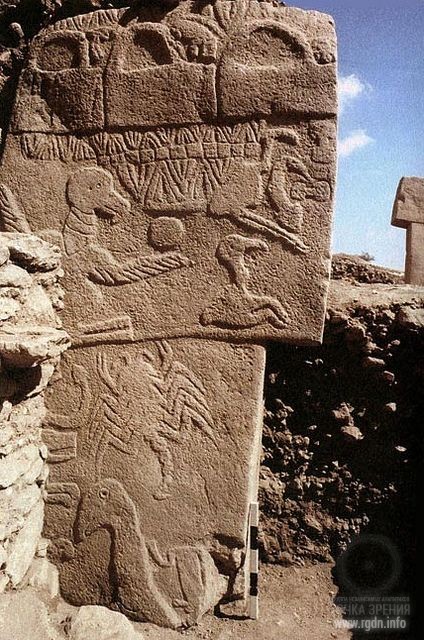
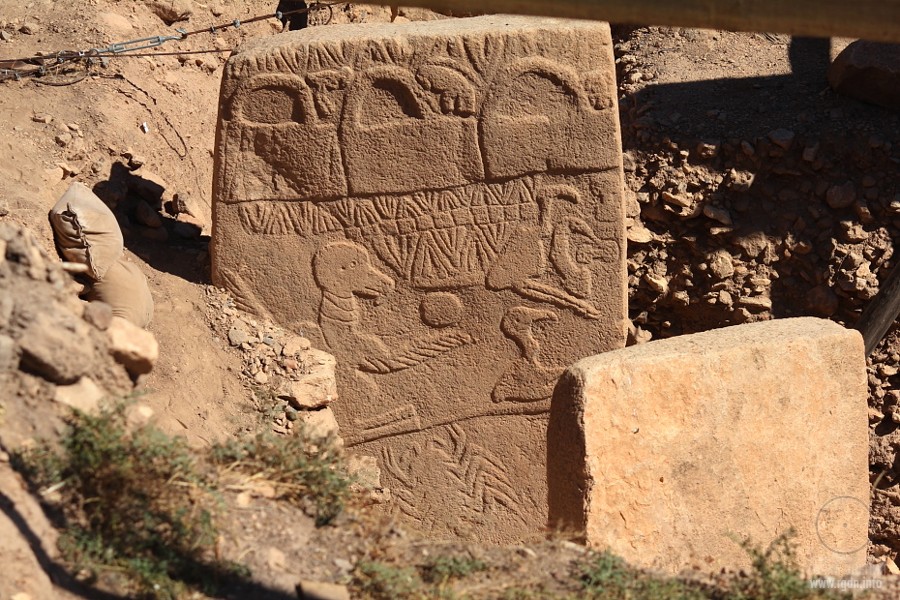
3. INTERPRETATION OF SYMBOLISM AT GÖBEKLI TEPE: WHAT DOES THE FOX SAY?
3.1. Pillar 43, Enclosure D – the Vulture Stone
We begin by noting the carving of a scorpion on pillar 43, a well-known zodiacal symbol for Scorpius. Based on this observation, we investigate to what extent other symbols on pillar 43 can be interpreted as zodiacal symbols or other familiar astronomical symbols. The possibility that ancient sites have astronomical significance in terms of alignment or symbolism has a long history; see for example theories about the famous Lascaux cave paintings, circa 15000 BC (Rappengluck, 2004).
Of course, an astronomical interpretation is not mandated by the presence of the scorpion; one might attempt interpretation instead in terms of hunting or migration patterns, mythology, or any other coherent system or framework. Indeed, we must also consider the possibility that the symbols on Pillar 43 were not intended to convey any specific meaning, beyond depictions of common animals. However, our basic statistical analysis (see later) indicates our astronomical interpretation is very likely to be correct. We are therefore content to limit ourselves to this hypothesis, and logically we are not required to pursue others. We now describe the evidence and logic for this interpretation.
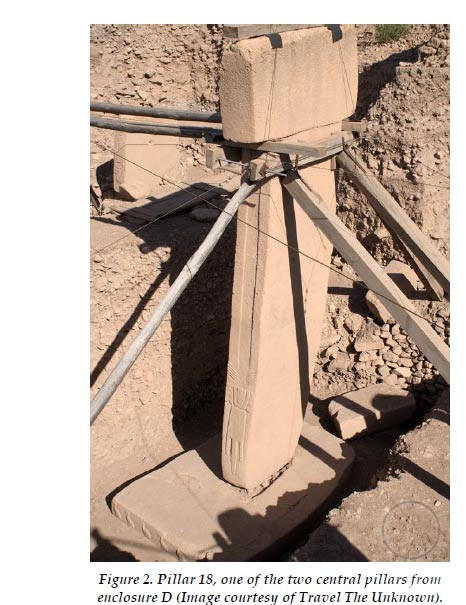
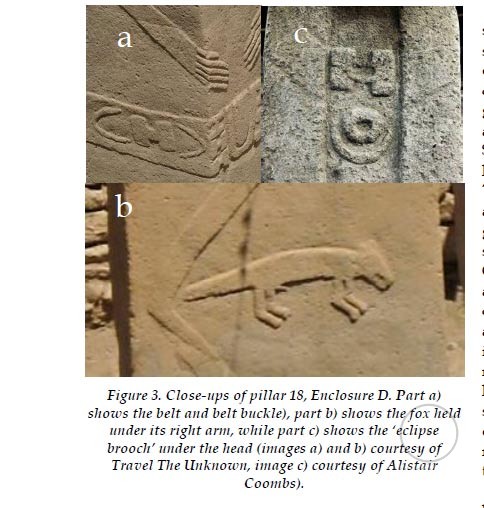
See Figure 5 for a view of the relevant part of the sky for the following discussion. The constellations shown correspond to those we are familiar with today (Western Lore in stellarium). We consider especially the neighbourhood around Scorpius. We suggest the vulture/eagle on pillar 43 can be interpreted as the ‘teapot’ asterism of our present-day notion of Sagittarius; the angle between the eagle/vulture’s head and wings, in particular, agrees well with the ‘handle’, ‘lid’ and ‘spout’ of the teapot asterism. We also suggest the ‘bent-bird’ with downward wriggling snake or fish can be interpreted as the ‘13th sign of the zodiac’, i.e. of our present-day notion of Ophiuchus. Although its relative position is not very accurate, we suggest the artist(s) of pillar 43 were constrained by the shape of the pillar. These symbols are a reasonably good match with their corresponding asterisms, and they all appear to be in approximately the correct relative locations. We are unsure how to interpret the squat bird to the right of the scorpion. It might represent the claws of our present-day notion of Scorpius, or another asterism not currently used. This possibility does not affect our statistical analysis or conclusions.
Next, we consider the goose / duck symbol at the bottom of the pillar. According to our present-day notions of the zodiacal signs, it should correspond to Libra. And indeed, Libra can be viewed as a swimming or floating bird, with upright neck and up-turned tail. Moreover, this view of Libra as a swimming long-necked bird is probably more intuitive than our current symbol for Libra – the Scales. One could argue that the form of the carving of the long-necked bird does not precisely fit the Libra constellation in terms of the position of corresponding stars. However, this symbol remains partly obscured, and moreover it is possible the artist(s) of Pillar 43 did not intend to depict an accurate star-map of the sky – rather their intention was perhaps to provide a symbolic representation of the order and approximate placement of the constellations as they saw it, sufficient to enable interpretation of pillar 43.
Next, consider the figure to the left of the scorpion. If our interpretation is correct, this should correspond to Lupus the wolf. And indeed, this figure is a good representation of a dog or wolf, although only the head and front legs are currently visible. At this point, with these symbols identified and in approximately the correct relative locations, the case for this interpretation of the date stamp is quite strong, but much more evidence is required, given the implications.
Let us now consider another feature of pillar 43. We suggest the carved circle in the visual centre of pillar 43 can be interpreted as the sun, and the pillar is communicating a date, i.e. it is a ‘date stamp’. Normally, the zodiacal epoch is defined by the position of the sun being ‘in’ a particular zodiacal sign at sunrise/sunset on one of four auspicious dates in the year; the spring equinox, summer solstice, autumnal equinox or winter solstice. Using stellarium it is easy to see, when the location is set to Sanliurfa in southern Turkey (which is about 10 miles from Göbekli Tepe) and when we consider these four events 1, that the hypothetical date stamp likely corresponds to one of the following four dates (with an error of around ± 250 years – see Figure 6);
2,000 AD – Winter solstice
4,350 BC – Autumnal equinox
10,950 BC – Summer solstice
18,000 BC – Spring equinox
______________________
1 Equinoxes are determined by finding the date when the sun intersects the equatorial plane. The summer solstice is determined by finding the date when the sun has the highest latitude. The winter solstice is determined by finding the date when the sun has the lowest latitude at its highest point of the day.
These dates correspond to those when, according to stellarium, the sun is slightly above the spout of the teapot asterism of Sagittarius, i.e. when the circle-sun is just above the right wing of the vulture on the pillar. Note, that it does not matter if we use the morning sunrise or evening sunset to locate the zodiacal sign – they give the same result. However, the orientation of the constellations with respect to the horizon does depend on the choice of sunrise or sunset, and for the best agreement with Pillar 43 we choose the sunset.
Let us now consider these dates. We understand Göbekli Tepe is an authentically ancient site, and we can certainly rule out 2,000 AD. Given the established radiocarbon date we can also rule out 4,350 BC. Of the remaining two dates, by far the closest to the radiocarbon date is 10,950 BC, based on the summer solstice, and we suggest therefore that this is the most likely date. When the uncertainty in this date estimate is taken into account, it is in very good agreement with an estimate for the date of the pro-posed YD event, 10,890 BC (Petaev et al., 2013).
This makes a strong case for this interpretation of pillar 43 – that it is referencing circa 10,950 BC, and hence the YD event. Certainly, we know of no reason to question the accuracy of stellarium. However, given the implications of this interpretation, further evidence is desirable.
Confidence in this interpretation can be improved further by considering the meaning of the ‘hand-bags’ and their accompanying figures at the top of the pillar. The date stamp corresponding to 10,950 BC is based on the summer solstice. Once again, using stellarium and Sanliurfa, if we locate the corresponding zodiacal sign on the preceding solstices and equinox we find the following sequence;
Spring equinox 10,950 BC = Virgo
Winter solstice 10,950 BC = Gemini
Autumn equinox 10,951 BC = Pisces
Now consider Figure 7, which shows the relevant constellations. Virgo at sunset can be interpreted as a downward crawling four-legged creature. Gemini at sunset can be interpreted as a standing quadruped. And Pisces at sunset can be interpreted as an angled creature. These notions agree very well with the three smaller zoomorphic carvings accompanying the three handbags, i.e.
Virgo = downward crawling frog
Gemini = charging ibex
Pisces = bending bird
Thus, we can interpret each handbag as indicating the preceding equinox or solstice. Indeed, the hand-bag symbol can be interpreted as a pictorial representation of a sunset (or sunrise), with the semi-circle representing the half-disc of the sun as it disappears below (or appears above) the horizon. We suggest the pillar therefore provides the four zodiacal signs of an entire year in the correct temporal order.
At this point we should take stock. According to this interpretation we have (vulture/eagle, scorpion, swimming bird, bending bird with wriggling fish/snake, wolf, lone bending bird, ibex, frog) = (Sagittarius, Scorpio, Libra, Ophiuchus, Lupus, Pisces, Gemini, Virgo). We ask, what is the probability that it is entirely coincidence that these patterns match each other, taking into account that some, e.g. Libra = swimming bird, might be abstractions rather than one-to-one pattern matches, and given that they have been placed in approximately the correct spatial locations? Our statistical analysis suggests it is less than one in 5 million (see Appendix). Based on this estimate we conclude that the probability that Pillar 43 is not a symbolic representation of the date 10,950 BC ± 250 years is very small indeed.
Finally, for Pillar 43, we can also estimate the probability of the perfect match of the date stamp to the YD event – it is around 500:6500, i.e. around 8%. This suggests an interpretation for the little headless man at the bottom; it is indicating probably the worst day ever in human history since the end of the ice age; the hypothetical YD catastrophe.
It is also worth noting that the patterns being matched here are animal symbols from a thirteen-thousand-year old megalith with the standard set of constellations or asterisms known today. We are not surprised that essentially the same stars are used in each case, but we do find it very interesting that similar patterns are used in most cases, because these are much more arbitrary. However, in most cases, it appears the people of GT had different interpretations for these patterns, i.e. they all appear to be individual animals with specific poses.
With this basic understanding that the animal symbols are very likely to be constellations, we might be able to decode much more of GT. But be-fore we move on to other pillars, we provide an interpretation for the abstract ‘H-symbols’ and nested ‘v-signs’ carved onto pillar 43. One possibility is that the H-symbols represent the position of Vega and/or Deneb, as both these stars would have appeared somewhat higher in the sky and slightly to the right (north) of the ‘downward wriggling snake’ (Serpens) around 10,950 BC. These bright stars would have been pole-stars in earlier millennia (Vega in circa 12,000 BC and Deneb in circa 16,000 BC), and it is possible that the people of Göbekli Tepe still referenced at least one of them, and even continued to use them to define north or a preferred direction. This possibility is supported by the general orientation of enclosure D [16], which is in the region of 5 to 10 degrees west of true north. This correlates reasonably well with the position of Vega in 10,950 BC, which would have been around 8 degrees west of true north at the sunset of the summer solstice. Vega and Deneb would have had an altitude of 42 and 67 degrees respectively at the time, and so both should have been visible from enclosure D (GT is built on the south side of a hill, near the top, on ground with a shallow gradient). Moreover, it has been suggested that Deneb also makes an appearance in the Lascaux caves (Rappengluck, 2004). Magli instead suggests the orientation of GT was designed to provide a good view of the rising of Sirius (Magli, 2016). While clearly a possibility, Magli does not provide any symbolic or statistical arguments to support this view. Others also suggest the alignment of GT is likely oriented to a feature in the southern sky, be-cause GT is built on the south side of a hill-top (Gonzalez-Garcia, 2016). We agree that observations to the south might have been a focus for the people of GT (see our later discussion of the Taurid meteor stream, which appears towards the south), but this does not preclude alignment of the central pillars towards another preferred direction. We suggest this preferred direction is a North/South axis defined relative to these earlier pole stars. In any case, the potential alignment of enclosure D towards any specific celestial object is not an important aspect of our interpretation as it does not feature in our statistical analysis and it makes no impact on our conclusions.
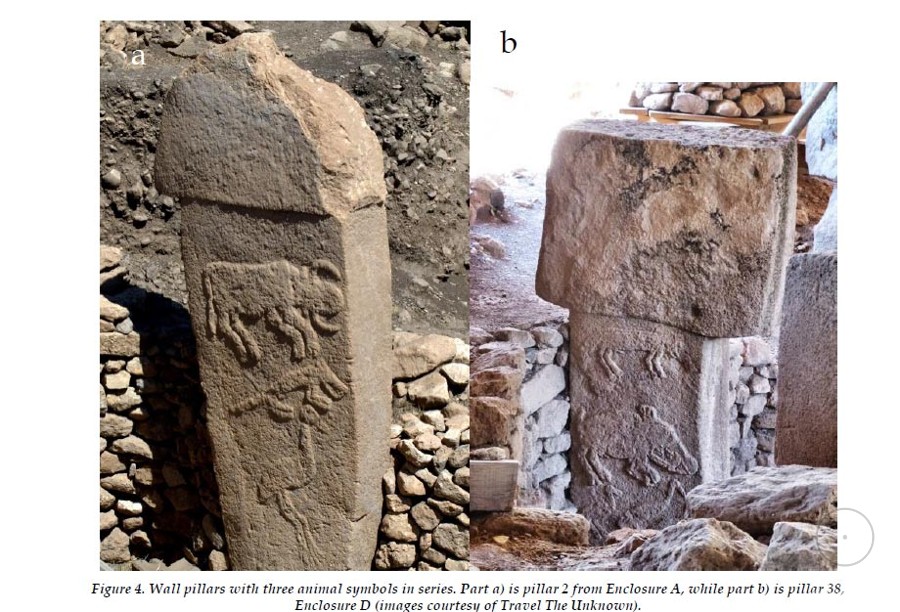
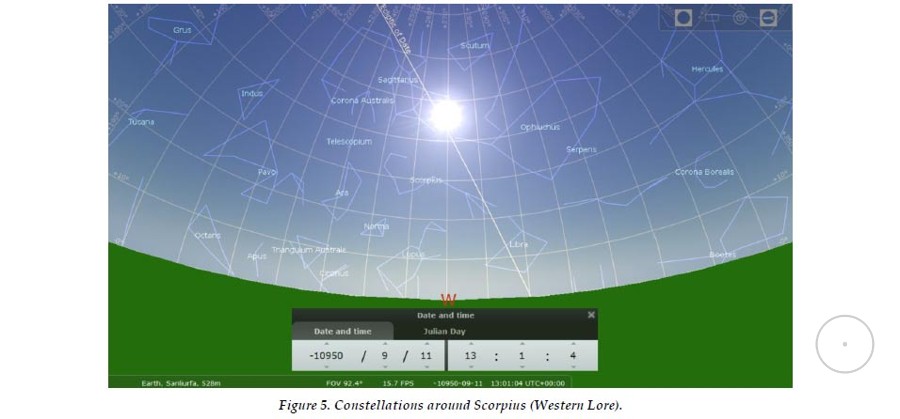
Regarding the ‘v-shapes’, we expect they are used for counting, but it is not clear what is being counted. Given their apparent expertise in astronomy, it is perhaps possible that these symbols can be used to refine the date stamp further, or perhaps they refer to the date when the pillar was ‘written’. For example, they might refer to the position of the moon, planets, comets or other astronomical objects or events.
To summarize, we suggest it is very likely that;
However, our interpretation of some of the more abstract symbols and connection to the YD event is rather speculative at this point.
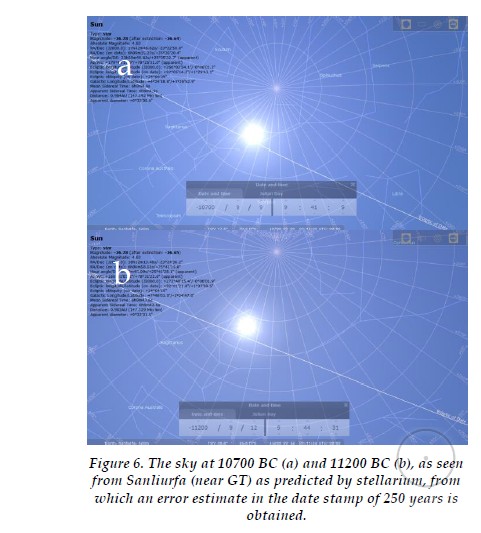
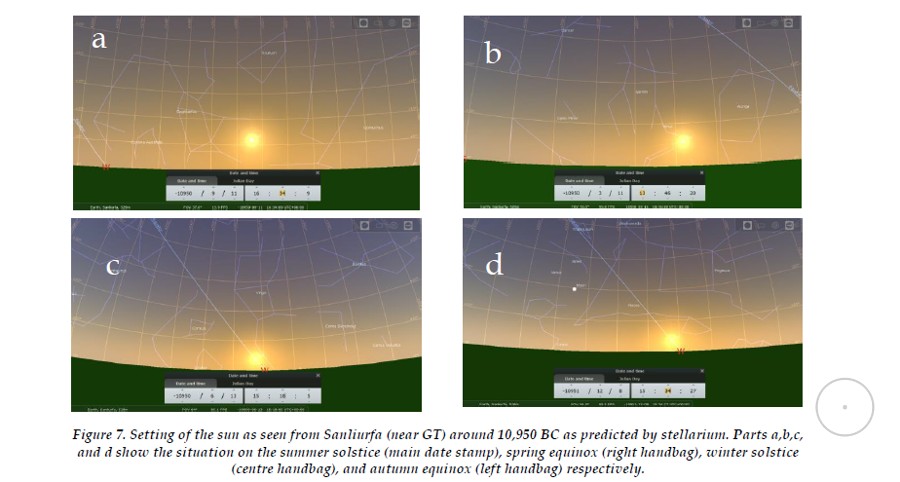
3.2. Pillar 18, Enclosure D
The symbolism of this central pillar is mainly abstract; the fox is the only animal carved here, but its meaning is unknown. This presents us with a cosmic riddle. Given the astronomical theme, and the presence of the fox symbol (which according to our interpretation should represent an asterism), it is sensible to enquire whether other symbolism is also astronomically related. Indeed, given the date stamp on Pillar 43 coincides with the hypothetical YD event, and a leading mechanism for the YD event is related to comets, it is sensible to ask whether other symbolism is specifically related to comets and meteor showers. As far as we are aware, this connection (between GT symbolism and comets) was first proposed by Collins (Collins, 2014), but his arguments are limited. The evidence he provides is summarized as follows;
Let’s consider these suggestions in turn;
Given our astronomical interpretation of the symbolism at GT, what other features can be viewed as evidence for observation of comets?
To summarize this section, our interpretation supports the suggestion that the symbolism of Pillar 18 is related to comets and their disastrous consequences. Yet although a reasonable hypothesis in view of the date stamp alone, it is still quite speculative, and the vulpine aspects of the fox carried under one arm and the fox-pelt loin cloth are curious. What does the fox say?
Before we provide an answer to this question, it is worth considering the implications of what we have learnt so far. If this interpretation is correct then it implies that;
We make a final suggestion in this section, that the date stamp on Pillar 43 indicates that the people of GT, (i.e. the people who built Pillar 43, or their ancestors), might have witnessed the proposed YD event and encoded the mechanism for the event at Göbekli Tepe. Indeed, perhaps Pillar 43 can be viewed as a memorial of this event.
3.3. Other pillars
To interpret the vulpine aspects of the central pillar we need a better understanding of the fox symbol. According to our interpretation, it should represent a constellation. We see the fox symbol elsewhere at GT. Let’s consider two other pillars that show a sequence of three animal symbols (these are the only pillars known to us with three animal symbols in a vertical series). First consider pillar 2, Enclosure A, which depicts the sequence (aurochs, fox, crane). According to our interpretation all three symbols represent asterisms, and the crane specifically represents Pisces. It is then sensible to consider the possibility that these three symbols represent neighbouring asterisms, i.e. the fox symbol represents a neighbour of Pisces, and the aurochs is a neighbour of the fox. Let’s also consider pillar 38, Enclosure D, which depicts the sequence (aurochs, boar, crane) (Schmidt, 2003). Now this is apparently inconsistent. How is it possible for two different asterisms to be directly between the same pair; aurochs and crane? What is the meaning here?
To answer this question, we can make use of the hypothesis that a primary function of GT was to ob-serve the night sky with a focus on comets, and in particular their associated meteor showers. When we use stellarium to investigate if any meteor showers radiate from near Pisces in 9,530 BC we find (see Figures 8 and 9), very interestingly, that the radiants of both the Northern and Southern Taurid meteor showers cross this region of the sky from early December to early February. In fact, according to stellarium, the Northern Taurids take the path (Pisces, Aries, Taurus), while the Southern Taurids take the path (Pisces, Cetus, Taurus). However, stellarium does not take account of the change in position of the radiants of these meteor showers over long timescales. To understand how the sky would really have looked in the period 9,530 BC we need to take account of precession of the nodes of their orbits. A good estimate of this rate of precession (Asher & Clube, 1998) is that it is around 6 degrees of longitude in the plane of the ecliptic in the direction of Aquarius, for both meteor streams, per 1000 years backwards in time. Therefore, in 9,530 BC when the rough stone walls were built, these radiants would all be shifted towards Aquarius by around 70 degrees, or just over two zodiacal constellations. Their latitude with respect to the ecliptic plane would have changed little, i.e. remained within ± 10 degrees, so the northern branch would have taken the path (Capricornus, Northern Aquarius, Pisces) while the southern branch would have taken the path (Capricornus, Southern Aquarius, Pisces). Noting the good match of the aurochs symbol with the constellation of Capricornus, this suggests the fox and boar represent northern and southern asterisms of Aquarius. By visual inspection, we suggest the fox represents the northern asterism, but we find it difficult to see right now how the boar represents the southern asterism of Aquarius. If our reading of the symbols on these pillars is correct (see Schmidt, 2003), we estimate 2 the probability that this observation is purely coincidental is around 2%.
______________________
2 The probability for three consecutive animal symbols to describe the radiant track of a meteor shower is not very different to the probability for two animal symbols to do the same because mete-or tracks tend to be quite linear. Therefore, the probability that it is a coincidence that both pillars describe the radiant tracks of meteor showers can be estimated as (m.C / y.t) 2, where m is the number of currently known meteor tracks that cross three constellations, y is the number of visible constellations, t is the average number of neighbours each constellation has, and C is a factor that takes account of the correlation between meteor tracks, i.e. C = 1 if there is no correlation and C2 = y.t if there is perfect correlation. We estimate m = 5, y = 30, t = 6, and C = 5 (since we know the tracks of the Northern and Southern Taurids, at least, are highly correlated). This gives an estimate of 2%.
Let’s summarize what has just happened. The proposal that low-relief animal symbols (except the snake) represent asterisms is almost certainly correct. But we are far less certain about the proposal that GT was designed to monitor comets and their mete-or showers. We then find an apparent contradiction of our first proposal that is resolved when we apply the second proposal. Logically, this implies significantly improved confidence in both proposals.
Altogether, this now makes a strong case for the meteor shower/comet hypothesis. Moreover, GT is ideally placed to observe these particular meteor showers, which would have been visible high in the southern sky for much of the night for a few winter months of each year in 9,530 BC.
To summarise this section, this match between the paths of the Northern and Southern Taurids in 9,530 BC and the carvings on these two pillars suggests that in addition to our earlier statements;
According to the catastrophist viewpoint, the Younger-Dryas event was probably caused by a cometary encounter with the Taurid complex. Can we now confirm this? No. What we can say is the following;
1) A great deal of physical evidence from a wide range of earth sciences appears to support the proposal that a major event occurred around 10,890 BC. A leading candidate for this event is a cometary encounter consistent with coherent catastrophism. The date stamp on pillar 43 corresponds closely with this date.
2) That the people of GT remained interested in this date even several millennia later suggests it was a very important event that had a significant impact on their cultural development.
3) The headless man on pillar 43 indicates the event lead to loss of life.
4) Symbolism on pillar 18 is consistent with an event of cosmic origin. The fox symbolism, in particular, suggests a cosmic event originating from a specific position. The belt-buckle, ‘eclipse’ and snake symbols are consistent with a cometary encounter. But the symbolism on pillar 18 might be consistent with other astronomical interpretations as well that we have not considered.
5) Pillars 2 and 38 indicate a special interest in the Taurid meteor stream, the same meteor stream pro-posed responsible for the YD event and the current period of coherent catastrophism. But the series of asterisms on these pillars might be consistent with other astronomical interpretations as well that we have not considered, or they might be entirely random sequences with no meaning. The statistics of the match certainly favours the Taurid meteor stream hypothesis, but they are not strong enough to be certain about this.
6) When all this evidence is considered together, it makes a strong case for the YD event as a cometary encounter, and hence for coherent catastrophism, that had a profound effect on the people at GT.
The proposal that Göbekli Tepe was, among other things, an observatory for monitoring the night sky, especially the Taurid meteor stream, because of the disastrous consequences of the YD event appears to be the most complete and consistent interpretation of its symbolism yet developed. Certainly, no other interpretation has the level of statistical support described here.
The implications of coherent catastrophism are profound, both for how we interpret evidence of past events (archaeology, geology, anthropology, climatology etc.), and potentially for how we plan for the future. Much more archaeology waits to be performed at Göbekli Tepe and neighbouring sites like Karahan Tepe. It will be very interesting to see how the additional evidence from these sites accumulates. Meanwhile, it seems prudent to take coherent catastrophism seriously.
Appendix: statistical test
Our hypothesis is that the low-relief symbols at GT (except snakes) usually represent star asterisms, and particularly on Pillar 43 they are used to represent a date close to 10,950 BC. Our challenge is to provide evidence to support this.
Here we tackle this problem by asking the following question: ‘Given the symbolism at GT, by considering all permutations of the available animal symbols at GT how many configurations of Pillar 43 can be found that are a better fit than the current one’. A ‘better fit’ is any permutation of symbols that provides a closer fit to the asterisms we suggest are symbolised in Pillar 43. In simple terms, we are asking ‘Given all the possible animal symbols that could have been carved on Pillar 43, how likely is it that the actual ones were chosen by pure chance, considering that they fit the asterisms for the date stamp better than almost any other combination?’
The probability that Pillar 43 does not represent the stated date is then simply 2(P+1)/Q, where P is the number of permutations that are better than the existing configuration, and Q is the number of all possible permutations. The factor of 2 arises because the ‘handbag’ symbols on Pillar 43 can equally be read left-to-right or right-to-left.
We can assume that any animal symbol found at GT can be used to replace the existing ones. The value of Q is then Xn, where X is the number of different animal symbols at GT and n = 8 is the number of animal symbols we consider on Pillar 43. Table 1 shows that, currently, X = 12, although this number might increase as further excavations at GT are carried out and more images become available. Hence Q is around 430 million.
One could argue that animal symbols on pillar 43 are unlikely to be repeated, i.e. we should eliminate any permutations that result in two or more symbols of the same kind appearing on Pillar 43. In this case, Q equals 8! multiplied by C8X, where C is a binomial coefficient (the number of different ways 8 symbols can be selected from a pool of X symbols), and 8! reflects the number of ways those 8 symbols can be arranged on the pillar. In this case, with X = 12, Q is around 20 million.
P+1 can be expressed as the product of (1 + the number of better symbols) for each position on Pillar 43. Again, we can ignore repeated symbols if they occur.
Table 1 shows the result of our analysis. That is, it shows the number of animal symbols at GT that we consider at least as good a fit as the existing symbol at that position on Pillar 43. We therefore conclude that the probability that Pillar 43 does not represent the date 10,950 BC is around one in 100 million, or one in 5 million if we neglect permutations with repeated symbols on Pillar 43. Considering these odds, it seems extremely likely that Pillar 43 does indeed represent the date 10,950 BC, to within 250 years.
These estimates only take into account the orientational ordering of animal symbols on Pillar 43 around the central scorpion symbol, given the pool of 12 animal symbols in Table 1. They do not take into account the accuracy with which these symbols are placed on Pillar 43 within this order. For example, these statistical estimates become even more significant if the good correlation between the location of the dog/wolf relative to the duck/goose and the vulture/eagle, and their corresponding asterisms, is considered. Taking into account the correlation between all statistical degrees of freedom would likely increase the significance of these estimates by a few orders of magnitude. Moreover, as more animal symbols are discovered at GT these estimates will become yet more significant, unless the new animal symbols are a better match for some of the asterisms suggested than the current set.
Table 1:Ranking of animal symbols according to how well they are perceived to fit the corresponding constellations that represent the date stamp 10950 BC suggested in the text. A few other animal symbols also appear at GT on the sides of pillars (e.g. wild ass, and possibly a wild sheep / mouflon), but their images are currently obscured.
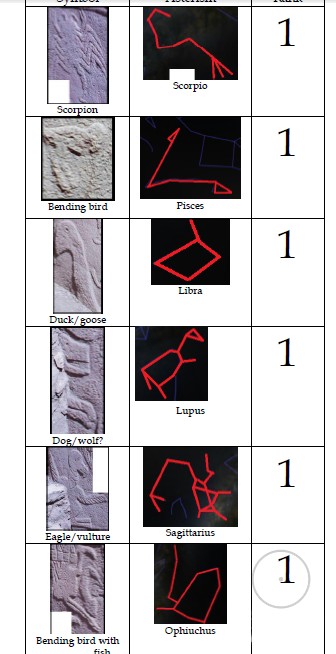
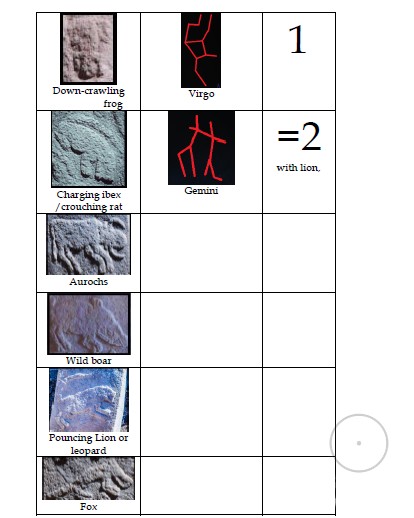

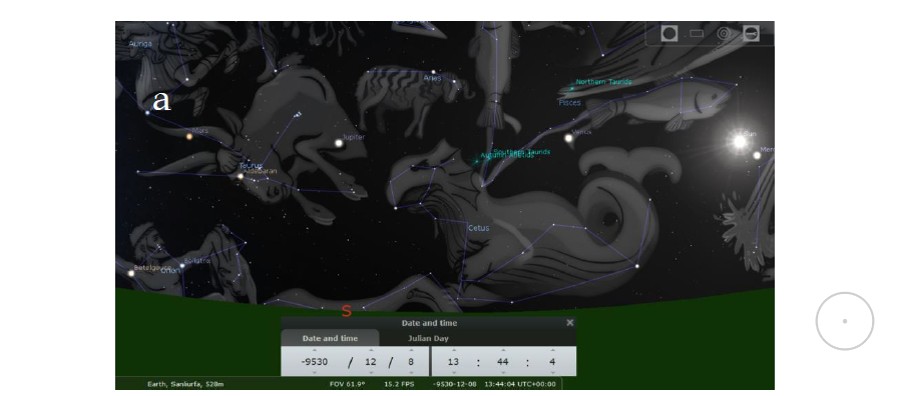
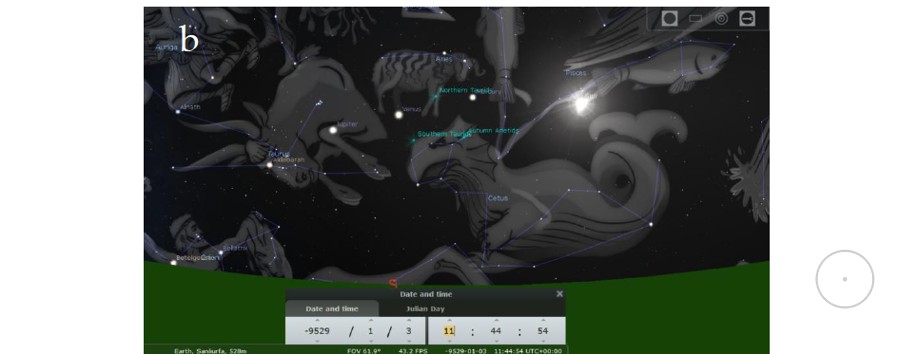
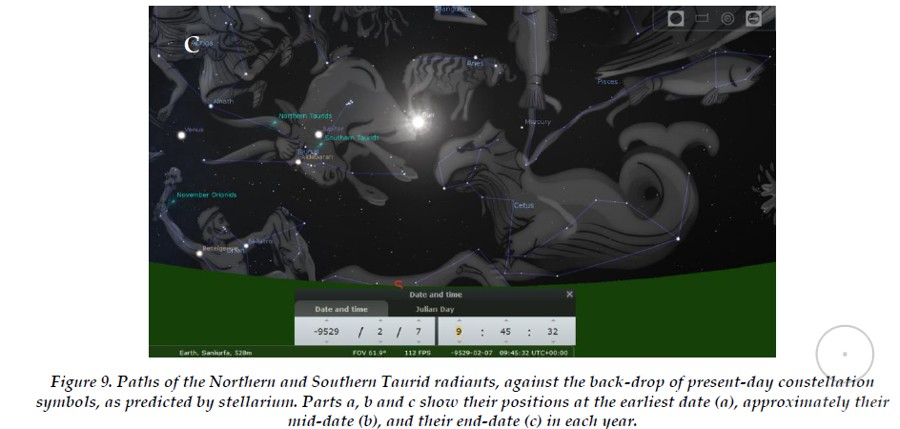
ACKNOWLEDGEMENTS
We thank Bill Napier and David Asher for very helpful comments on the manuscript and guidance with the celestial mechanics of the Taurid complex. MBS thanks Alison Monk for recognising the significance of the ‘handbags’. We also thank ‘Travel the Unknown’ (www.traveltheunknown.com) and Alistair Coombs for free use of their images and three anonymous referees for constructive comments.
Mediterranean Archaeology and Archaeometry, Vol. 17, No 1, (2017), pp. 233-250
Copyright © 2017 MAA
Open access. Printed in Greece. All rights reserved.
DOI:10.5281 / zenodo.400780
KEYWORDS: symbolism, Younger Dryas, comet, Taurid meteor, asterism, coherent catastrophism
 Decoding Göbekli Tepe with archaeoastronomy. What does the Fox say?
votes:
95
Decoding Göbekli Tepe with archaeoastronomy. What does the Fox say?
votes:
95
|

Project Aim










Leave comment